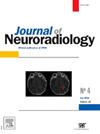Imaging follow-up of unruptured intracranial aneurysms treated with flow diverter: Insights from a French collaborative survey
IF 3
3区 医学
Q2 CLINICAL NEUROLOGY
引用次数: 0
Abstract
Purpose
The absence of standardized guidelines for imaging follow-up of unruptured intracranial aneurysms treated with flow diverters (FD) results in significant variability across centers. This survey aims to provide a comprehensive overview of current imaging follow-up practices in French academic centers.
Methods
In April 2024, a 49-question survey was distributed to interventional neuroradiology centers in France through the trainee-led research collaborative network, Jeunes En Neuroradiologie Interventionnelle-Research Collaborative (JENI-RC). The survey covered follow-up protocols for digital subtraction angiography (DSA), magnetic resonance imaging (MRI), and computed tomography (CT), as well as potential modifications for specific cases.
Results
Twenty interventional neuroradiology centers responded to the survey. Most centers (n = 14, 70 %), conducted a single systematic DSA either at 6 or 12 months post-procedure. In most centers (n = 13, 65 %), a second DSA was scheduled only based on the results of the first, specifically in cases of non-occluded aneurysm, intimal hyperplasia, or in-stent stenosis. MRI follow-up varied, with most centers (n = 12, 60 %) performing three MRIs over five years. Only two centers included CT scans in their protocols.
Conclusion
This survey highlights the substantial heterogeneity in imaging follow-up protocols for FD-treated unruptured intracranial aneurysms among French academic centers. The findings underscore the urgent need for standardized guidelines to harmonize practices, optimize patient outcomes, and improve resource utilization. Additionally, innovations in FD technology, advancements in MRI sequences, and the advent of photon-counting CT will likely influence follow-up practices in the near future.
血流分流术治疗未破裂颅内动脉瘤的影像学随访:来自法国合作调查的见解
目的:由于血流分流器(FD)治疗未破裂颅内动脉瘤的影像学随访缺乏标准化指南,导致各中心的影像学随访存在显著差异。本调查旨在提供法国学术中心目前影像学随访实践的全面概述。方法2024年4月,通过实习生领导的研究协作网络Jeunes En Neuroradiologie interonnel - research collaborative (JENI-RC)向法国的介入神经放射学中心分发了一份49个问题的调查问卷。该调查涵盖了数字减影血管造影(DSA)、磁共振成像(MRI)和计算机断层扫描(CT)的随访方案,以及针对特定病例的潜在修改。结果20家介入神经放射学中心参与了调查。大多数中心(n = 14,70 %)在术后6个月或12个月进行了单次系统DSA。在大多数中心(n = 13,65 %),仅根据第一次DSA的结果安排第二次DSA,特别是在未闭塞的动脉瘤、内膜增生或支架内狭窄的情况下。MRI随访各不相同,大多数中心(n = 12,60 %)在五年内进行了三次MRI。只有两个中心在他们的方案中包括了CT扫描。结论:在法国各学术中心,fd治疗未破裂颅内动脉瘤的影像学随访方案存在很大的异质性。研究结果强调,迫切需要标准化的指导方针,以协调实践,优化患者的结果,并提高资源利用。此外,FD技术的创新、MRI序列的进步以及光子计数CT的出现可能会在不久的将来影响后续的实践。
本文章由计算机程序翻译,如有差异,请以英文原文为准。
求助全文
约1分钟内获得全文
求助全文
来源期刊

Journal of Neuroradiology
医学-核医学
CiteScore
6.10
自引率
5.70%
发文量
142
审稿时长
6-12 weeks
期刊介绍:
The Journal of Neuroradiology is a peer-reviewed journal, publishing worldwide clinical and basic research in the field of diagnostic and Interventional neuroradiology, translational and molecular neuroimaging, and artificial intelligence in neuroradiology.
The Journal of Neuroradiology considers for publication articles, reviews, technical notes and letters to the editors (correspondence section), provided that the methodology and scientific content are of high quality, and that the results will have substantial clinical impact and/or physiological importance.
 求助内容:
求助内容: 应助结果提醒方式:
应助结果提醒方式:


